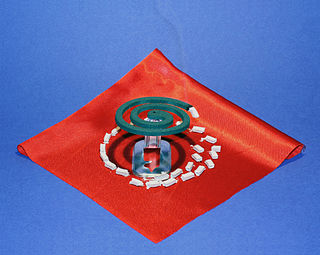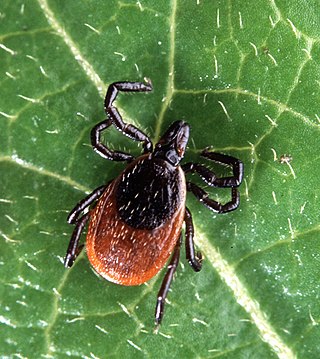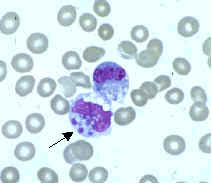
N,N-Diethyl-meta-toluamide, also called diethyltoluamide or DEET, is the oldest, most effective and most common active ingredient in commercial insect repellents. It is a slightly yellow oil intended to be applied to the skin or to clothing and provides protection against mosquitoes, flies, ticks, fleas, chiggers, leeches, and many other biting insects.
Tick-borne diseases, which afflict humans and other animals, are caused by infectious agents transmitted by tick bites. They are caused by infection with a variety of pathogens, including rickettsia and other types of bacteria, viruses, and protozoa. The economic impact of tick-borne diseases is considered to be substantial in humans, and tick-borne diseases are estimated to affect ~80 % of cattle worldwide. Most of these pathogens require passage through vertebrate hosts as part of their life cycle. Tick-borne infections in humans, farm animals, and companion animals are primarily associated with wildlife animal reservoirs. Many tick-borne infections in humans involve a complex cycle between wildlife animal reservoirs and tick vectors. The survival and transmission of these tick-borne viruses are closely linked to their interactions with tick vectors and host cells. These viruses are classified into different families, including Asfarviridae, Reoviridae, Rhabdoviridae, Orthomyxoviridae, Bunyaviridae, and Flaviviridae.

An insect repellent is a substance applied to the skin, clothing, or other surfaces to discourage insects from landing or climbing on that surface. Insect repellents help prevent and control the outbreak of insect-borne diseases such as malaria, Lyme disease, dengue fever, bubonic plague, river blindness, and West Nile fever. Pest animals commonly serving as vectors for disease include insects such as flea, fly, and mosquito; and ticks (arachnids).

Dermacentor variabilis, also known as the American dog tick or wood tick, is a species of tick that is known to carry bacteria responsible for several diseases in humans, including Rocky Mountain spotted fever and tularemia. It is one of the best-known hard ticks. Diseases are spread when it sucks blood from the host. It may take several days for the host to experience symptoms.

The discipline of medical entomology, or public health entomology, and also veterinary entomology is focused upon insects and arthropods that impact human health. Veterinary entomology is included in this category, because many animal diseases can "jump species" and become a human health threat, for example, bovine encephalitis. Medical entomology also includes scientific research on the behavior, ecology, and epidemiology of arthropod disease vectors, and involves a tremendous outreach to the public, including local and state officials and other stake holders in the interest of public safety.

Ixodes is a genus of hard-bodied ticks. It includes important disease vectors of animals and humans, and some species inject toxins that can cause paralysis. Some ticks in this genus may transmit the pathogenic bacterium Borrelia burgdorferi responsible for causing Lyme disease. Additional organisms that may be transmitted by Ixodes are parasites from the genus Babesia, which cause babesiosis, and bacteria from the related genus Anaplasma, which cause anaplasmosis.

Ixodes scapularis is commonly known as the deer tick or black-legged tick, and in some parts of the US as the bear tick. It was also named Ixodes dammini until it was shown to be the same species in 1993. It is a hard-bodied tick found in the eastern and northern Midwest of the United States as well as in southeastern Canada. It is a vector for several diseases of animals, including humans and is known as the deer tick owing to its habit of parasitizing the white-tailed deer. It is also known to parasitize mice, lizards, migratory birds, etc. especially while the tick is in the larval or nymphal stage.

Amblyomma is a genus of hard ticks. Some are disease vectors, for example the Rocky Mountain spotted fever in United States or ehrlichiosis in Brazil.

Amblyomma americanum, also known as the lone star tick, the northeastern water tick, or the turkey tick, is a type of tick indigenous to much of the eastern United States and Mexico, that bites painlessly and commonly goes unnoticed, remaining attached to its host for as long as seven days until it is fully engorged with blood. It is a member of the phylum Arthropoda, class Arachnida. The adult lone star tick is sexually dimorphic, named for a silvery-white, star-shaped spot or "lone star" present near the center of the posterior portion of the adult female shield (scutum); adult males conversely have varied white streaks or spots around the margins of their shields.

Human monocytotropic ehrlichiosis is a form of ehrlichiosis associated with Ehrlichia chaffeensis. This bacterium is an obligate intracellular pathogen affecting monocytes and macrophages.
VectorBase is one of the five Bioinformatics Resource Centers (BRC) funded by the National Institute of Allergy and Infectious Diseases (NIAID), a component of the National Institutes of Health (NIH), which is an agency of the United States Department of Health and Human Services. VectorBase is focused on invertebrate vectors of human pathogens working with the sequencing centers and the research community to curate vector genomes.

Ixodes pacificus, the western black-legged tick, is a species of parasitic tick found on the western coast of North America. I. pacificus is a member of the family Ixodidae. It is the principal vector of Lyme disease in that region. I. pacificus larvae and nymphs typically feeds on lizards and small mammals, while adults typically feed on deer. It is an ectoparasite that attaches itself to the outside of its host and feeds on the host's blood. It can have a heteroxenous lifestyle or monoxenous life cycle depending on how many hosts it feeds on in each cycle. I. pacificus has a four stage life cycle that takes around 3 years to complete. These stages include egg, larva, nymph, and adult. They prefer dense woodland habitats or areas of brush and tall grass.

Ixodes uriae, also known as the seabird tick, is a species of parasitic tick known to infest marine birds. It is native to many high latitude areas in the northern and southern hemispheres including Alaska, Canada, Faroe Islands, Iceland, Greenland, England, Scotland, Norway, Finland, the Kola Peninsula, Russia, Patagonia, South Africa and Australia.

Ethyl butylacetylaminopropionate is an insect repellent whose trade name is IR3535 and was developed and commercialized by Merck KGaA (Germany). It is a colorless and odorless oil with a good skin feel in final products, and it is biodegradable.

Haller's organ is a complex sensory organ possessed by hard and soft ticks. Not found outside of Acari, it is proposed to function like the chemosensation of insect antennae, but is structurally different. Ticks, being obligate parasites, must find a host in order to survive. Bloodmeals are necessary for completion of the life cycle, including reproduction and ontogenetic development. First described in 1881, it was named for its discoverer, Haller. While Haller initially proposed it was involved in auditory sensation, this was rejected in favor of olfactory sensation by 1905. This theory was supported by Lee's behavioral studies as early as 1948.

Callicarpenal is a terpenoid that has been isolated from plants of the genus Callicarpa (beautyberry). It acts as an insect repellent against mosquitoes and fire ants. It also has activity against ticks.
Tibovirus is a term often used to describe viruses that are transmitted by tick vectors. The word tibovirus is an acronym. This falls within the superorder arthropod thus tibovirus is classified under Arthropod Borne virus (Arborvirus). For a person to acquire infection the tick must bite and feed for a sufficient period of time. The tiboviruses that affect humans are limited to within 3 families: Flaviviridae, Reoviridae, and Bunyaviridae.
Paul Schulze was "the most important German tick taxonomist of the early 20th century." Between 1929 and 1937, he described 19 genera, 17 subgenera, 150 species and 150 subspecies of ixodid ticks. He was essentially an amateur taxonomist, working alone for most of his career, not consulting the major tick collections or collaborating with other tick taxonomists.
Maria Tonelli-Rondelli was an Italian entomologist who studied the taxonomy and identification of ticks (Ixodidae), especially South American species.


















